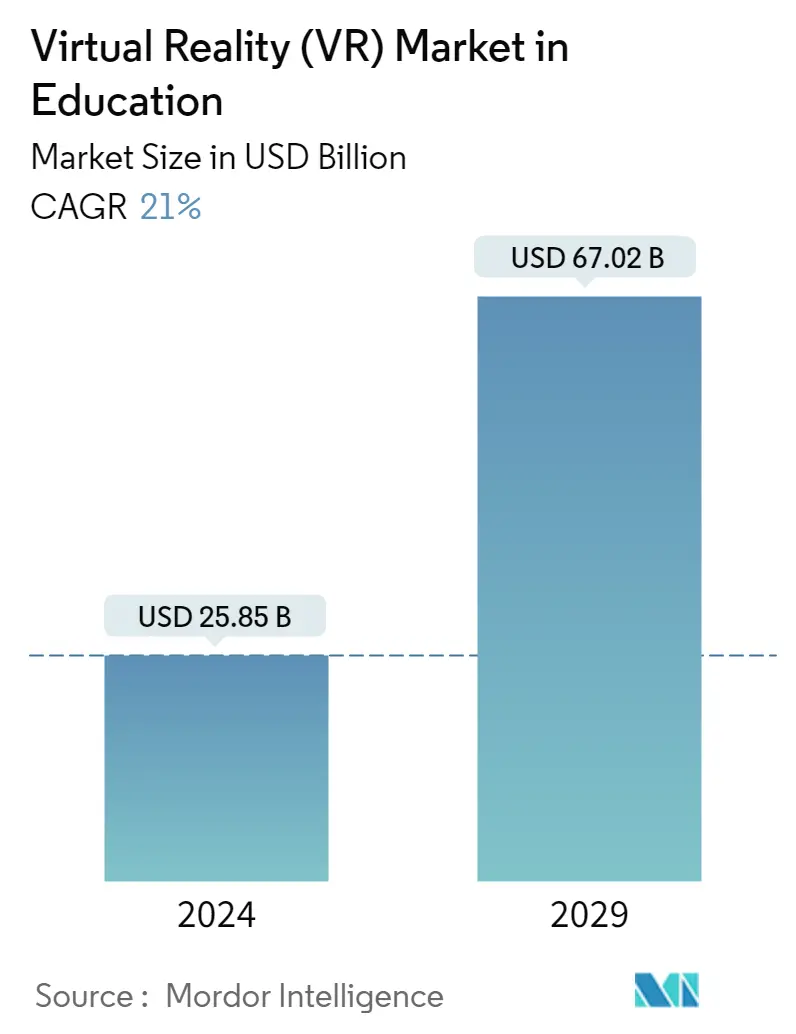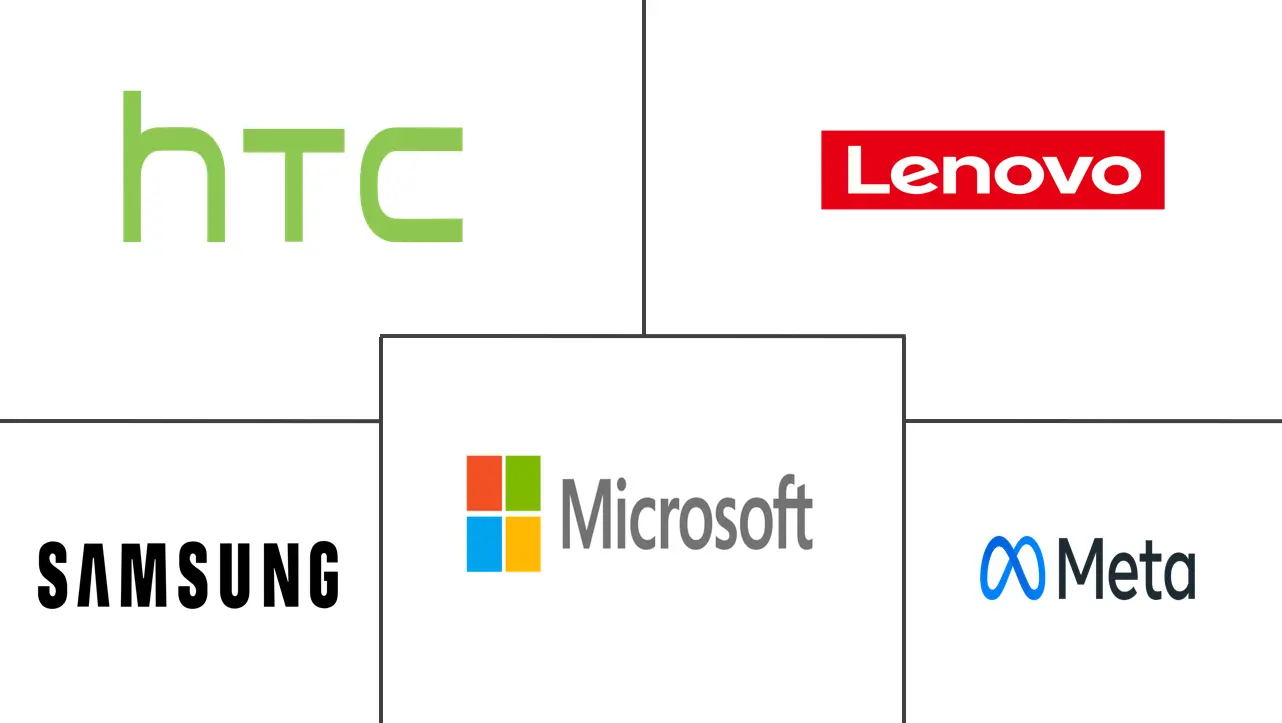Market Size of Virtual Reality (VR) Industry in Education

| Study Period | 2019 - 2029 |
| Market Size (2024) | USD 25.85 Billion |
| Market Size (2029) | USD 67.02 Billion |
| CAGR (2024 - 2029) | 21.00 % |
| Fastest Growing Market | North America |
| Largest Market | North America |
Major Players
*Disclaimer: Major Players sorted in no particular order |
Virtual Reality (VR) in Education Market Analysis
The Virtual Reality Market in Education Industry is expected to grow from USD 25.85 billion in 2024 to USD 67.02 billion by 2029, at a CAGR of 21% during the forecast period (2024-2029).
VR technology has gained widespread recognition and adoption over the past few years. Recent technological advancements in this field have revealed new enterprises and adoption among major universities, colleges, and schools for advanced learning experiences. In addition, the market is expected to gain significant demand from corporations for corporate learning programs in the coming years.
- Virtual reality has gained significant traction in the education world over the past few years. It offers learners an immersive experience: they can learn complicated subject matters by entering a reality-imitating virtual world where they can move, talk, make decisions, and interact with the world around them. Such an instance led to increased demand for virtual reality in education.
- Educational institutions have started incorporating practical learning through excursions, lab experiments, group activities, and projects. The introduction of virtual reality in education has taken learning to an entirely new dimension. Immersive learning through Virtual Reality has proven to be an effective tool for expanding knowledge. It delivers digitally created information and situations that mirror real-life experiences that are mostly inaccessible to learners in traditional school settings.
- Many companies are making learning interactive and more engaging through VR technologies by adding gaming elements to textbook material. For instance, Curiscope's Virtuali-tee is a t-shirt and app that lets users learn about the human body. One person puts on the t-shirt while the other uses a virtual reality app on a smartphone to virtually reveal and explore the various layers inside the body.
- Further, VR is finding extensive applications in biology, with universities and colleges worldwide using virtual reality headsets for immersive learning. For instance, last year, students at Arizona State University were learning biology in a unique virtual reality experience, hurtling through space to interact with creatures in an intergalactic wildlife sanctuary the size of a small city and to solve the mystery of why the animals are dying.
- During the COVID-19 lockdown, technologies like AR, VR, and MR witnessed significant demand as they allowed people to shop, talk, and socialize using these immersive platforms. The COVID-19 pandemic moved learners and young students out of the classroom and into the virtual world of remote education. Many universities and schools are now taking advantage of virtual reality technology to improve access to education, both in terms of helping pupils with learning difficulties or disabilities and making learning less location-dependent.
Virtual Reality (VR) in Education Industry Segmentation
Virtual reality involves the creation of simulated environments that imitate real objects or persons to create an illusion. The creation of such an illusion helps people understand the actual environments of an industry, arena, space, or situation. Virtual reality has applications across various industries, such as education, entertainment, defense, and healthcare, which are projected to bring in key revenues into the global market.
The Virtual Reality(VR) Market in Education is Segmented by Type ( Hardware, Software, and Services (Training and Consulting and Managed Services)), End User( Academic Institutions (K-12 Learning, Higher Education), and Corporate Training (IT and Telecom, Healthcare, Retail, and E-commerce)), and Geography. The market sizes and forecasts are provided in terms of value (USD million) for all the above segments.
| Type | |
| Hardware | |
| Software | |
| Services (Training and Consulting and Managed Services) |
| End User | ||||||
| ||||||
|
| Geography | |
| North America | |
| Europe | |
| Asia Pacific | |
| Rest of the World |
Virtual Reality (VR) Market in Education Size Summary
The virtual reality market in education is experiencing significant growth, driven by the increasing adoption of immersive technologies in educational institutions and corporate training programs. VR technology has become a pivotal tool for enhancing learning experiences, offering students the opportunity to engage with complex subjects in a virtual environment that simulates real-world scenarios. This shift towards immersive learning is transforming traditional educational methods, making learning more interactive and engaging. The integration of VR in education is not only limited to academic institutions but is also gaining traction in corporate settings, where companies are utilizing VR for employee training and development. The demand for VR in education is further fueled by the need for flexible and accessible learning solutions, especially in the wake of the COVID-19 pandemic, which accelerated the shift towards remote education.
The market is characterized by a moderate level of competition, with numerous companies and startups innovating to enhance VR technologies and applications. North America, particularly the United States, is at the forefront of this growth, benefiting from a robust technology ecosystem and high smartphone penetration. The region's telecom companies are also investing in 5G technology to support the development of VR applications, further propelling market expansion. Globally, initiatives such as partnerships between educational boards and tech giants, as well as collaborations between universities and VR companies, are contributing to the widespread adoption of VR in education. As the cost of VR systems continues to decrease and interest in the technology grows, the market is expected to see continued expansion, with significant advancements anticipated in the coming years.
Virtual Reality (VR) Market in Education Market Size - Table of Contents
-
1. MARKET DYNAMICS
-
1.1 Market Overview
-
1.2 Industry Attractiveness - Porter's Five Forces Analysis
-
1.2.1 Bargaining Power of Suppliers
-
1.2.2 Bargaining Power of Consumers
-
1.2.3 Threat of New Entrants
-
1.2.4 Threat of Substitutes
-
1.2.5 Intensity of Competitive Rivalry
-
-
1.3 Industry Ecosystem Analysis
-
1.3.1 Hardware
-
1.3.2 Software and App Development
-
1.3.3 Content Creators
-
1.3.4 Service Providers
-
1.3.5 Network Providers
-
1.3.6 End Users
-
-
1.4 Market Drivers
-
1.4.1 Increasing demand for interactive and personalized learning experience
-
1.4.2 Higher acceptance among stakeholders owing to higher engagement and scope for blended learning technology
-
1.4.3 VR-based technology benefits from being the first entrant in the education & corporate category
-
1.4.4 The role of education and training among corporates has transformed with the growth in digital engagement and compelling content
-
-
1.5 Market Restraints
-
1.5.1 Limited content and cost efficiency of consumer-grade applications
-
1.5.2 Dependence on external factors, such as bandwidth and network, for ensuring optimal experience
-
-
1.6 Market Opportunities
-
1.6.1 Growth in budget allocation on interactive learning by education bodies and the corporate sector
-
1.6.2 Technological advancements to make content accessible to a wider audience
-
-
1.7 VR App Distribution and Pricing Model Analysis in the Education Sector
-
1.8 Key-use cases and Implementation case studies
-
1.8.1 China's implementation of VR in classrooms
-
1.8.2 The Corporate sector initiatives toward VR training for service standardization
-
1.8.3 Implementation of virtual field trips through Google's offering
-
-
1.9 Technology Snapshot
-
1.10 Assessment of Impact of COVID-19 on the Industry
-
-
2. MARKET SEGMENTATION
-
2.1 Type
-
2.1.1 Hardware
-
2.1.2 Software
-
2.1.3 Services (Training and Consulting and Managed Services)
-
-
2.2 End User
-
2.2.1 Academic Institutions
-
2.2.1.1 K-12 Learning
-
2.2.1.2 Higher Education
-
-
2.2.2 Corporate Training
-
2.2.2.1 IT and Telecom
-
2.2.2.2 Healthcare
-
2.2.2.3 Retail and E-commerce
-
2.2.2.4 Other End users
-
-
-
2.3 Geography
-
2.3.1 North America
-
2.3.2 Europe
-
2.3.3 Asia Pacific
-
2.3.4 Rest of the World
-
-
Virtual Reality (VR) Market in Education Market Size FAQs
How big is the Education Virtual Reality (VR) Market?
The Education Virtual Reality (VR) Market size is expected to reach USD 25.85 billion in 2024 and grow at a CAGR of 21% to reach USD 67.02 billion by 2029.
What is the current Education Virtual Reality (VR) Market size?
In 2024, the Education Virtual Reality (VR) Market size is expected to reach USD 25.85 billion.

